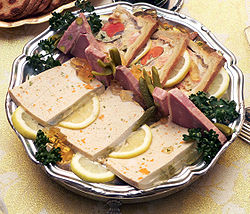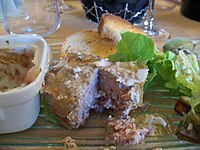food.wikisort.org - Dish
Pâté (UK: /ˈpæteɪ/ PAT-ay, US: /pɑːˈteɪ, pæˈ-/ pa(h)-TAY, French: [pɑte] (![]() listen)) is a paste, pie or loaf filled with a forcemeat. Common forcemeats include ground meat from pork, poultry, fish or beef; fat, vegetables, herbs, spices and either wine or brandy (often cognac or armagnac). It is often served on or with bread or crackers.[1]
listen)) is a paste, pie or loaf filled with a forcemeat. Common forcemeats include ground meat from pork, poultry, fish or beef; fat, vegetables, herbs, spices and either wine or brandy (often cognac or armagnac). It is often served on or with bread or crackers.[1]
This article needs additional citations for verification. (June 2017) |
 Various pâtés | |
| Place of origin | France, Belgium, Vietnam and Laos |
|---|---|
| Main ingredients | Meat, fish, seafood, or vegetables |
Pâté can be served either hot or cold, but it is considered to develop its best flavors after a few days of chilling.[2]
Variations
In French or Belgian cuisine, pâté may be baked in a crust as pie or loaf, in which case it is called pâté en croûte, or baked in a terrine (or other mold), in which case it is known as pâté en terrine.[3] Traditionally, a forcemeat mixture cooked and served in a terrine is also called a terrine. The most famous pâté is probably pâté de foie gras, made from the livers of fattened geese.[2]
Pâté en croûte is baked with the insertion of "chimneys" on top: small tubes or funnels that allow steam to escape, thus keeping the pastry crust from turning damp or soggy. Baked pâté en croûte usually develops an air bubble under the crust top as the meat mixture shrinks during baking; this is traditionally dealt with by infusing semi-liquid aspic in the hollow space before chilling.
In Poland, pasztet is made from poultry, fish, venison, ham, or pork with eggs, flour, bread crumbs, and a varied range of additions, such as pepper, tomato sauce, mushrooms, spices, vegetables, ginger, nutmeg, cheese, or sugar.
In Russia, the dish is mostly prepared with beef, goose or chicken liver[4] and thus is commonly known as pechyonochniy pashtet (Russian: печёночный паштет, "liver pâté"); however, other meats also can be used. Unlike the Western European method, the liver is first cooked (boiled or fried) and mixed with butter or fat and seasoning such as fresh or fried onion, carrots, spices and herbs.[5] It can be further cooked (usually baked), but most often is used without any other preparation. In Russia, the pâté is served on a plate or in a bowl, and is often molded into the shapes of animals, such as hedgehogs.[6]
A similar recipe is known as chopped liver in Ashkenazi Jewish cuisine, with schmaltz used instead of butter and hard-boiled eggs usually added. Another common type of pâté in Jewish cuisine, also popular in Russia and Ukraine, is vorschmack or gehakte herring (chopped herring).[7][8]
In the former Yugoslavia, pašteta or паштета (a thinly pureed pâté) is a popular bread spread usually made from liver, chicken, pork, ham, beef, turkey or less commonly tuna or salmon.[citation needed]
In Vietnamese cuisine, pâté is commonly used on bánh mì baguette-type sandwiches.[9] Pâté of this type is more commonly made from liver.
- Wild boar terrine
- Chopped liver
- Vorschmack (chopped herring)
Liver sausage
In much of northern and central Europe, there are soft, spreadable sausages made primarily with liver and sometimes confused with pâté.
See also
- Cretons
- Chopped liver
- Fatback
- Galantine
- Gefilte fish
- Head cheese
- Offal
- Rillettes
- Leverpostej
- Liver spread
- List of spreads
- Livermush
References
- "Pâté Etiquette | How to Eat... | Table Manners | Etiquette Scholar". www.etiquettescholar.com. Retrieved 2022-01-11.
- Julia Child (1964). Mastering the Art of French Cooking. New York, New York (USA): Alfred A. Knopf. pp. 564–576. ISBN 9785879620764. Retrieved 12 October 2017.
- "Demystifying French Soft Charcuterie". MICHELIN Guide. Retrieved 2021-07-02.
- enjoyyourcooking.com
- "Pork Liver Pâté - Nomadic Fork pork liver pate low carb". Nomadic Fork. 2020-06-14. Retrieved 2022-01-11.
- Darra Goldstein (1999). A Taste of Russia: A Cookbook of Russian Hospitality. Russian Information Service. p. 33. ISBN 9781880100424. Retrieved 12 October 2017.
- В. В. Похлебкин. Национальные кухни наших народов. Москва, изд. Пищевая пром-сть, 1980. Еврейская кухня. (William Pokhlyobkin. The Ethnic Cuisines of our Peoples. Moscow, Food Industry publishing house, 1980; Russian)
- Елена Молоховец (1861). Подарок молодым хозяйкам (in Russian). Санкт-Петербург. A Gift to Young Housewives, English translation: Joyce Stetson Toomre (1998). Classic Russian Cooking: Elena Molokhovets' a Gift to Young Housewives. Indiana University Press. ISBN 978-0-253-21210-8.
- Pork and Pâté Vietnamese Sandwich (Banh Mi)
External links
 The dictionary definition of pâté at Wiktionary
The dictionary definition of pâté at Wiktionary
На других языках
- [en] Pâté
[ru] Паштет
Паште́т (нем. Pastete — «паштет, пирожок»[1], «оболочка из теста преимущественно цилиндрической формы для пикантного рагу, блюдо из рубленого мяса, дичи или рыбы, запечённое в оболочке из теста или сервированное в террине»[2]) — изысканное закусочное блюдо в форме вязкой однородной тестообразной массы из отваренного или жареного и затем протёртого мяса, рыбы, дичи и субпродуктов[3]. К паштетам относится форшмак[4]. Похожее блюдо в европейской кухне — террин, нечто среднее между паштетом и холодцом[5]. Наиболее известным паштетным блюдом в СССР был деликатесный и диетический печёночный из говяжьей печени, было налажено промышленное производство разнообразных консервированных паштетов, мясных (из дичи, печени с другими субпродуктами, ливерный) и рыбных (из лососевых, из обжаренной рыбы, из печени тресковых, паштет шпротный[6].Другой контент может иметь иную лицензию. Перед использованием материалов сайта WikiSort.org внимательно изучите правила лицензирования конкретных элементов наполнения сайта.
WikiSort.org - проект по пересортировке и дополнению контента Википедии



